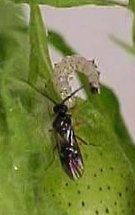
Microplitis adult approaching a helicoverpa larva. Photo: R Lloyd.
Microplitis demolitor is a small native parasitoid wasp, one of the key beneficial insect species that attack Helicoverpa sp. caterpillars in Australia. Female wasps can parasitise approximately 70 helicoverpa caterpillars in their lifetime, and also play an important role in spreading ascovirus.
Ascovirus lethally infects a range of caterpillar species. The ascovirus that infects helicoverpa and other Noctuid species, such as armyworms (Spodeptera sp.), is transmitted between caterpillars by female Microplitis, Heteropelma and Netelia parasitoid wasps.
Together microplitis and ascovirus can have a significant impact on helicoverpa populations, especially when these populations are low and/or close to the economic threshold. The percentage of helicoverpa caterpillars killed by microplitis parasitism and resulting ascovirus infection can exceed 75%, although 30-50% is more typical.
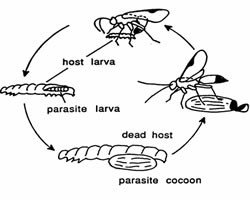
Life cycle of Microplitis demolitor
On this page:
Lifecycle and ecology
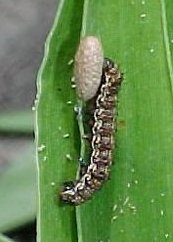
Microplitis cocoon next to a parasitised larva. Photo: B Scholz.
From egg to adult, the microplitis life cycle takes about 12 days. This is made up of seven days from egg laying to forming a pupa (pupation), and then five days for pupal development.
Wasps have a preference for second instar helicoverpa caterpillars (4-7 mm). Third and fourth instar caterpillars are also suitable as Microplitis hosts, but are parasitised less frequently because they vigorously defend themselves, sometimes injuring or killing the wasp. Occasionally, twin parasitoids emerge from a single host and rarely (about 1% of cases) the host caterpillar survives and pupates normally after the wasp has emerged.
When a female wasp lays an egg into an ascovirus-infected caterpillar she picks up the disease on her ovipositor (stinger). When she stings subsequent caterpillars, her contaminated ovipositor infects those caterpillars until the viral load on the ovipositor reduces to nil.
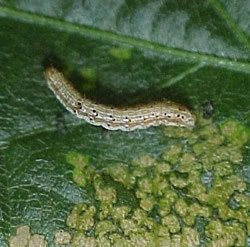
An ascovirus-infected caterpillar grazing on leaf material. © State of Queensland
When ascovirus particles enter the caterpillar´s body they multiply in tissue cells, eventually infecting the haemolymph (blood). This causes the haemolymph to change from clear to milky. The caterpillar stops eating, but may not die for several days or weeks, surviving in a lethargic state.
Ascovirus establishes in the helicoverpa population through spring-summer. The disease is transmitted from caterpillar to caterpillar by wasps (such as microplitis), however it can also be directly transmitted by spitting or cannibalism. The way in which ascovirus survives winter is currently unknown. It could persist in low numbers of helicoverpa, or use alternative hosts such as spodoptera larvae (e.g. cluster caterpillars and armyworms).
Detecting in the field
Microplitis adults are small (3 mm) black-brown wasps. Active throughout the day, they are often seen flying slowly above the crop canopy in search of caterpillar hosts. If microplitis is active in a crop, sweep netting will often capture wasps that are in the plants.
Parasitised caterpillars will only grow to about 15 mm (about half the size of a healthy caterpillar), so caterpillars ≤15cm are potentially microplitis hosts.
Parasitised helicoverpa caterpillars cause about 90% less crop damage before they die compared to unparasitised caterpillars. Because they do so little damage, do not include parasitised caterpillars in counts during crop scouting.
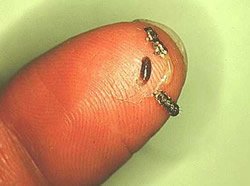
Sampling helicoverpa larva for Microplitis parasitism. Photo: B Scholz
To identify parasitism, perform a simple split test: hold the caterpillar across a forefinger with one thumb on the rear end of the caterpillar, and the other thumb on the head. Gently stretch the caterpillar until the skin ruptures. A microplitis larva developing within the caterpillar looks like a maggot up to 4 mm long. Microplitis larvae darken as they mature.
Ascoviruses are not related to the commercially available NPVs (Vivus Gold®, Gemstar®). A caterpillar infected with NPV will turn black, liquidise and splatter. Ascovirus infection produces much more subtle symptoms, such as lethargy, cloudy haemolymph and reduced appetite. Infected larvae usually stop eating within 48 hours, but may not die for several days, or sometimes weeks.
Including microplitis/ascovirus in pest management decisions
As a general rule, microplitis has greater impact on near-threshold helicoverpa populations than against populations in excess of the economic spray threshold for that crop.
If we consider the example of a crop where the economic threshold is 2 caterpillars/m2, 50% parasitism by microplitis will reduce a population of 3 caterpillars/m2 to below threshold, but will not be effective on its own against a population of 10 caterpillars/m2.
The overall effectiveness of microplitis is related to the abundance of the wasp in the farming system. Microplitis is active in all crops attacked by helicoverpa except chickpea (the plant´s acid secretions deter predators and parasitoids).
Microplitis numbers generally start off low in the spring and increase during the season (provided there are hosts present), eventually peaking by late summer. In early spring, even low numbers of microplitis can parasitise a significant proportion of the helicoverpa population because the helicoverpa numbers are also low (e.g. in spring mungbeans, sunflowers and sorghum).
Crop scouting data can be used to check for microplitis. Because the wasp parasitises second instar caterpillars (4-7 mm), parasitoid activity should be suspected in situations when previous counts have shown the presence of eggs and very small caterpillars, but these do not seem to be developing through to third instar caterpillars and larger (i.e. longer than 15 mm). Although this situation might also be due to other natural enemies, combined with the above observations, it is a good indication that microplitis is exerting some control on the helicoverpa population.
High ascovirus levels can eventually cause microplitis numbers to decline. When a parasitised caterpillar is killed by ascovirus, so is the microplitis larva developing inside.
Minimising insecticide disruption
Broad-spectrum insecticides will kill microplitis. Even a biological insecticide (e.g. NPV or Bt) can kill microplitis larvae if the host caterpillar is killed before the parasitoid can complete its development. The cocoon (pupal stage) of microplitis is less susceptible to insecticides than the adult and larval stages.
In crops where there is a range of life-stages present, it is not practical to try and time sprays to preserve microplitis. However, in sorghum, where helicoverpa egg lay occurs over a relatively short period around flowering (10 days), NPV should be applied at three days after 50% of heads in the field have completed flowering (that is, brown anthers to the base of the head). This timing allows most of the microplitis larvae time to emerge before their caterpillar hosts are killed by the NPV infection.
